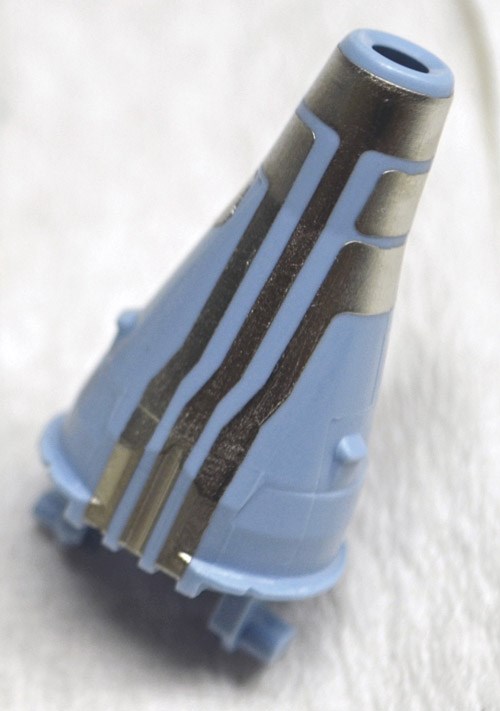Heat is on for Plating Temperature Probe
Conductive and durable plating of ThermoScan Pro 6000 tip at SAT Plating in Troy, Michigan.
Welch Allyn required a best-in-class plating supplier to plate a critical component of its breakthrough ear speculum device to measure human body temperatures. The company found the help it needed at SAT Plating in Troy, Michigan.
First, some background. Within the medical community, measuring body temperature is critical to effectively treat patients. Current technology may lead to inaccurate readings resulting in potentially serious errors in patient care. Welch Allyn and partner companies Kaz and Keytronic created the Braun ThermoScan Pro 6000, with advanced design and algorithms that more accurately measures body temperature.
Integral to the success of the ThermoScan Pro 6000 is the conductive and durable plating in requisite areas of the probe tip, which is inserted into the ear to take a temperature reading. This piece is a molded, multi-shot plastic component that requires selective plating of copper and nickel in three discrete bands that measure temperature in various locations within the ear canal.
Welch Allyn required the probe tip be highly reliable with a long life. The probe tip was created using multi-shot molding of plastics; one plastic that is readily plateable PC/ABS and the other chemically resistant polysulfone (PSU).

The ThermoScan Pro 6000 tip.
The Welch Allyn team could not find a supplier with the necessary technology to plate the PC/ABS of the probe tip with excellent adhesive and conductive plating without jeopardizing the tight dimensional tolerances of the component. The first shot material (PSU) is significantly degraded in a matter of 60 to 90 seconds in chromic acid etch, which is standard in plating of plastic.
SAT’s unique solution was to pretreat the plastics with their proprietary Surface Activation process.
“This technology atomically alters the surface of the plastic using no abrasive blasting or hazardous chemical etching of the substrate,” says John Wallace, president of SAT Plating.
The result enabled the second shot material (PC/ABS) to be plated with required copper and nickel, without altering any of the tight tolerance geometries of the plastic component (PSU).
“Throughout the product development process, several test batches of racking tips were required to determine the most effective combination of metals and finishes to provide optimum product effectiveness and look,” says Debbie Maguire, SAT’s technical sales director.
Custom-made pre-production and production racks were designed and manufactured to maximize processing efficiency and quality requirement outcomes.
SAT Plating was formed in 2006 to develop a technology for increasing the adhesion of metal plating to engineered plastics, and expand the range of polymer options available to manufacturers, engineers, designers and purchasing departments. They did so by developing a suite of processes they call “Adaptive Plating Technologies.”
“It enables our clients to employ new and innovative approaches to their product design, material selection and production methodologies,” says Wallace. “And it often achieves higher performance with lower cost.”
Information for this story supplied by SAT Plating; for additional information, please call 248-273-0037 or visit them at satplating.com.
Originally published in the April 2016 issue.
Related Content
-
Advantages to Pumped Eductor Agitation
Not all agitation methods are created equally. Pumped agitation with eductor nozzles can improve process tanks and quickly show a reduction in operating costs while keeping staff safe, following environmental legislation and preventing pollution.
-
Products Finishing Reveals 2024 Qualifying Top Shops
PF reveals the qualifying shops in its annual Top Shops Benchmarking Survey — a program designed to offer shops insights into their overall performance in the industry.
-
An Overview of Electroless Nickel Plating
By definition, electroless plating is metal deposition by a controlled chemical reaction.















